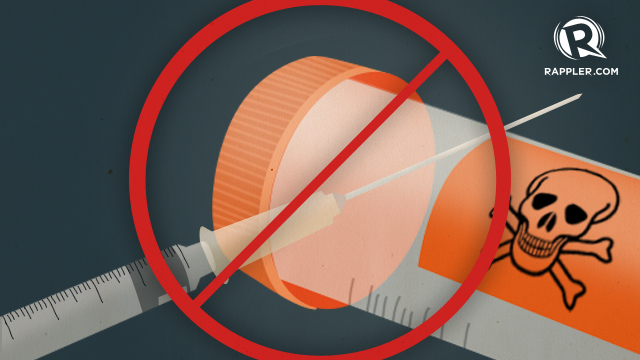SUMMARY
This is AI generated summarization, which may have errors. For context, always refer to the full article.

MANILA, Philippines – The Philippines reaffirmed its commitment against capital punishment at the 5th World Congress Against Death Penalty, in a “strongly worded” speech Wednesday, June 12, in Madrid, Spain.
Speaking on behalf of President Benigno Aquino III, Justice Secretary Leila De Lima delivered a speech where she said “every person is equal before the law, and that each life holds intrinsic value, which no person – no State – can or should take.”
“I believe that imposing the death penalty cannot fully deter crime. I believe in a system where each citizen is empowered to take hold his destiny, enabling him to uplift his family, community, and nation,” the speech said.
The Philippines was the first country in Asia to abolish the death penalty under the ratified Constitution in 1987. It was, however, re-imposed through Republic Act No. 759 in 1992 but once again abolished by members of Congress on June 24, 2006.
In the speech, Aquino said his government’s strategy to prevent crimes in the Philippines rests on “an empowered citizenry, a skilled and trusted law enforcement sector, an effective prosecutorial service, and an independent judiciary.”
The speech also acknowledged that the Philippines has been facing challenges in making legal services and making them more accessible to the majority of Filipinos. But it said the “administration is determined to address these challenges by setting in place not only the right policies, but more importantly the right people for the job.”
De Lima echoed Aquino’s stand against the capital punishment and said the government’s “practical and urgent reason” for its universal abolition has also been for the protection of Overseas Filipinos Workers (OFWs).
“Some have had the misfortune for getting entangled in criminal cases in foreign jurisdiction, which include those that impose death penalty, where they are in a distinct disadvantage due to certain factors, such as language barriers and social or cultural differences,” De Lima explained.
De Lima said the government’s aim has been to “ensure that [Filipinos] are always assured of receiving adequate and competent legal representation and support for the defense of their rights.”
The World Congress, attended by about 1,500 international participants, ended on Saturday, June 15.
Marcos regime
In explaining his position against death penalty, the speech cited the President’s “personal experiences” under the rule of former President Ferdinand Marcos Jr.’s.
Aquino’s father, the late Senator Benigno ‘Ninoy’ Aquino Jr., was the staunchest critic of Marcos. Aquino recalled that during martial law, his father was charged with murder, subversion, and illegal possession of firearms.
Aquino explained that his father was “sentenced by farcical legal theater to die” adding that if not for the objection of the international community, Marcos would not have allowed his father to travel abroad and seek medical care.
“The sorrow my family had to endure and the suffering that I witnessed as I grew up impressed upon me the moral imperative to not only detest death penalty, but more importantly to defend the right of every person, guilty or not, to live with dignity,” the speech said.
In 1965-1972, prior to the imposition of martial law by Marcos, Amnesty International reported that a total of 19 executions of death penalty took place, with 12 executions carried out in 1967 alone.
According to Amnesty International, 12 other executions took place during the martial law period including the execution of heroin smuggler Lim Seng broadcasted on television. These figures, however, are not inclusive of the alleged summary executions and human rights violations of the Marcoses.
Abolition and reinstatement
The courts implemented the death penalty until it was abolished under the 1987 Constitution on February 2, 1987.
However, the same section under the Bill of Rights of the 1987 Constitution abolishing the death penalty had conditions to allow its reinstatement.
Section 19. “x x x Neither shall death penalty be imposed, unless, for compelling reasons involving heinous crimes, the Congress hereafter provides for it. Any death penalty already imposed shall be reduced to reclusion perpetua.”
In December 1993, President Fidel V. Ramos enacted Republic Act (R. A.) No, 7659, which reinstated death penalty in the Philippines because of an “alarming upsurge of crimes.”
According to Amnesty International, there were 170-estimated conviction in 1997, 400 in 1998, and 350 in 1999 in the Philippines.
The first execution after the reinstatement of death penalty took place in 1999 during the administration of former President Joseph Ejercito Estrada. Leo Ecehegaray was put to death by lethal injection on February 5, 1999.
But by June 24 2006, under Estrada’s successor, former president Gloria Macapagal-Arroyo, the death penalty was again abolished with the enactment of Republic Act (R.A.) No. 9346. R.A. 9346 commuted the death sentence to reclusion perpetua or life imprisonment.
According to the Department of Justice, from 1946 to present, there have been about 73 executions of death penalty in the Philippines. – Rappler.com
Add a comment
How does this make you feel?
There are no comments yet. Add your comment to start the conversation.